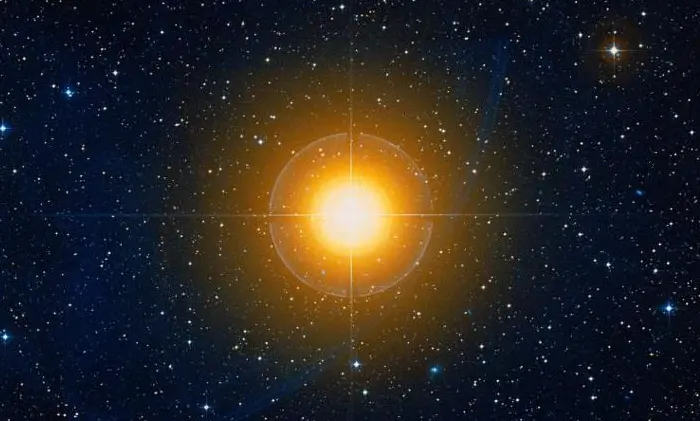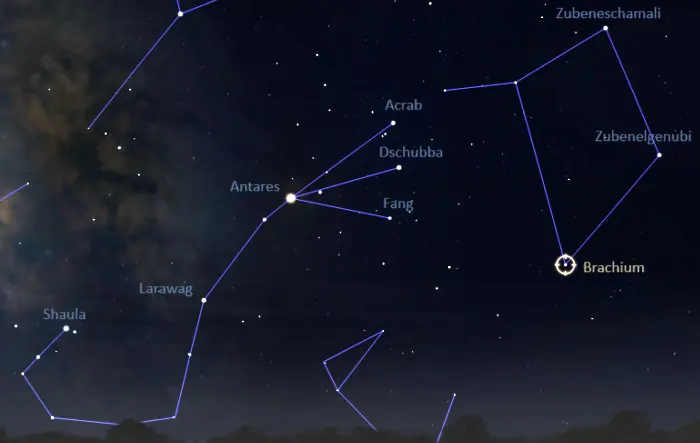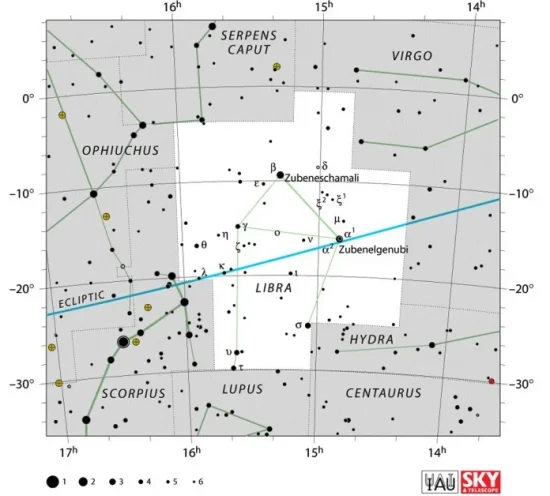Brachium, Sigma Librae A (σ Lib A) is the primary component of a binary star system located approximately 288 light-years from the solar system in the constellation Libra. It appears near the border with Hydra. With an apparent magnitude that varies between 3.20 and 3.46, it is the third brightest point of light in Libra, after Zubeneschamali and Zubenelgenubi.
Star system
Sigma Librae is a binary star with an average apparent magnitude of 3.29. The two components, Sigma Librae A and Sigma Librae B, are separated by more than an arcminute.
The primary component, Brachium (Sigma Librae A), is a red giant star of the spectral type M2.5 III. It has a mass 2.2 times that of the Sun and a radius of 108 solar radii. With a surface temperature of 3,596 K, the giant is 1,820 times more luminous than the Sun.
Brachium is currently on the asymptotic giant branch (AGB). It is a cool luminous star whose main source of energy is the fusion of hydrogen and helium in shells around an inert carbon-oxygen core.
The companion, Sigma Librae B, is a 16th magnitude star.
Brachium is classified as a semiregular variable star of the type SRb. These stars are giants of late spectral classes whose variation periods differ in duration. Sigma Librae A has a pulsation period of 20 days. Its brightness varies by 0.10 – 0.15 magnitudes over periods of 15 – 20 minutes, with repetition cycles occurring every 2.5 – 3 hours.
Other relatively bright stars in this class include Tiaki (Beta Gruis) in the constellation Grus, Mirach (Beta Andromedae) in Andromeda, Rho Persei (Gorgonea Tertia) in Perseus, La Superba (Y Canum Venaticorum) in Canes Venatici, RR Ursae Minoris in Ursa Minor, and R Doradus in Dorado.

Brachium (Sigma Librae), image: Wikisky (DSS)
Facts
Brachium is on average the 221st brightest star in the sky. With a mean visual magnitude of 3.29, it is about as bright as Skat (Delta Aquarii) in the constellation Aquarius, Omega Carinae in Carina, Edasich (Iota Draconis) in Draco, and Alpha Doradus, the brightest star in Dorado.
The Sigma Librae system would appear 0.20 ± 0.17 magnitudes brighter without the extinction caused by interstellar dust and gas.
In traditional Chinese astronomy, Brachium was known as 折威七 (Shé Wēi qī), the Seventh Star of Executions. Executions was an asterism formed by Sigma Librae with 50 Hydrae, 3 Librae, 4 Librae, and 12 Librae. The asterism was part of the Neck mansion, which represented the neck of the Azure Dragon.
Name
The name Brachium (pronunciation: /ˈbreɪkiəm/) is the Latin word for “arm.”
The International Astronomical Union’s (IAU) Working Group on Star Names (WGSN) approved the name on September 5, 2017. The name formally applies only to the primary component, Sigma Librae A.
Sigma Librae was also traditionally known as Cornu, which means “corn” in Latin. It shared the name Zuben el Genubi, which is Arabic for “the southern claw,” with Alpha Librae, now formally known as Zubenelgenubi. It was also sometimes called Zuben Hakrabi or Zuban Alakrab (“the claws of the Scorpion”). Sigma Librae shared these names with Gamma Librae and Eta Librae. The name Zubenelhakrabi now formally applies only to Gamma Librae.
Location
Brachium is relatively easy to find because it appears in the same region of the sky as the bright stars of Scorpius. It can be found by extending a line from Antares through Fang, the southernmost bright star of the Scorpion’s claws.

The location of Brachium (Sigma Librae), image: Stellarium
Constellation
Brachium is located in the constellation of Libra. Libra is one of the 48 ancient constellations catalogued by the Greco-Roman astronomer Ptolemy of Alexandria in his Almagest in the 2nd century CE. It is the 29th largest constellation in the sky, stretching across 538 square degrees. Like all zodiac constellations, it lies on the ecliptic (the Sun’s apparent path across the sky).
Libra represents the weighing scales. In ancient Babylon, it was known as MUL Zibanu (“the scales” or “balance”). The ancient Greeks saw it as the Scorpion’s claws. The Romans saw it as the scales held by Astraea, the goddess of justice. The equivalent in Greek mythology is the goddess Dike, associated with the constellation Virgo.
Libra contains only two stars brighter than magnitude 3.0 – Zubeneschamali and Zubenelgenubi – and does not stand out in the sky next to the brighter Scorpius. However, the scales pattern can be made out near the Scorpion’s claws on a clear night. The constellation contains a total of 83 visible stars (brighter than magnitude 6.5), but most of these are invisible from light-polluted areas.

Libra constellation map by IAU and Sky&Telescope magazine
Zubeneschamali (Beta Librae), the brightest star in Libra, is a hot blue B-type main sequence star located 185 light-years away. It shines at magnitude 2.61. Other notable stars of Libra include the multiple star system Alpha Librae (Zubenelgenubi), the orange giants Upsilon Librae, the binary stars Tau Librae and Gamma Librae (Zubenelhakrabi), the yellow giant Theta Librae, the quadruple star system Iota1 Librae, the Sun-like star 23 Librae, which hosts two exoplanets, and the red dwarf Gliese 581, which hosts a system of at least three planets.
Libra is also home to HE 1523-0901 and the Methuselah Star (HD 140283), both among the oldest stars known. The red giant HE 1523-0901 has an estimated age of 13.2 billion years and the subgiant Methuselah is believed to be around 12 billion years old.
Deep sky objects in Libra include the globular cluster NGC 5897, the barred spiral galaxies NGC 5885 and NGC 5792 and NGC 5728, the active spiral galaxy NGC 5793, and the interacting spiral galaxy NGC 5917.
The best time of the year to see the stars and deep sky objects in Libra is during the month of June, when the constellation appears higher above the horizon in the early evening. The entire constellation is visible from locations between the latitudes 65° N and -90° S.
The 10 brightest stars in Libra are Zubeneschamali (Beta Lib, mag. 2.61), Zubenelgenubi (Alpha Lib, mag. 2.741), Brachium (Sigma Lib, mag. 3.29), Upsilon Librae (mag. 3.628), Tau Librae (mag. 3.68), Zubenelhakrabi (Gamma Lib, mag. 3.91), Theta Librae (mag. 4.136), 16 Librae (mag. 4.49), Iota1 Librae (mag. 4.54), and 37 Librae (mag. 4.61).
Brachium – Sigma Librae
| Spectral class | M2.5III |
| Variable type | Semiregular variable (SRb) |
| U-B colour index | +1.94 |
| B-V colour index | +1.70 |
| Apparent magnitude | 3.20 – 3.46 |
| Absolute magnitude | –1.5 |
| Distance | 288 ± 6 light years (88 ± 2 parsecs) |
| Parallax | 12.5387 ± 0.2984 mas |
| Radial velocity | -3.90 ± 0.7 km/s |
| Proper motion | RA: -73.484 ± 0.445 mas/yr |
| Dec.: -42.632 ± 0.599 mas/yr | |
| Mass | 2.2 M☉ |
| Luminosity | 1,820 L☉ |
| Radius | 108 R☉ |
| Temperature | 3,596 K |
| Metallicity | 0.00 dex |
| Surface gravity | 0.9 ± 0.3 cgs |
| Constellation | Libra |
| Right ascension | 15h 04m 04.2148093680s |
| Declination | –25° 16′ 55.090486596″ |
| Names and designations | Brachium, Sigma Librae, σ Librae, σ Lib, 20 Librae, HD 133216, HR 5603, HIP 73714, SAO 183139, FK5 556, GC 20253, GCRV 8717, GJ 9508, GJ 574.1, CD–24 11834, CPD-24 5432, PLX 3400.00, CSV 7165, PPM 263746, GSC 06752-01455, AKARI-IRC-V1 J1504041-251655, JP11 2566, UBV 13042, WEB 12601, WISEA J150404.20-251655.5, IRAS 15011-2505, 2MASS J15040422-2516549, TYC 6752-1455-1, SRS 30556, AAVSO 1458-24, Gaia DR2 6227443304909889536, Gaia DR3 6227443304915069056, WDS 15041-2517 |